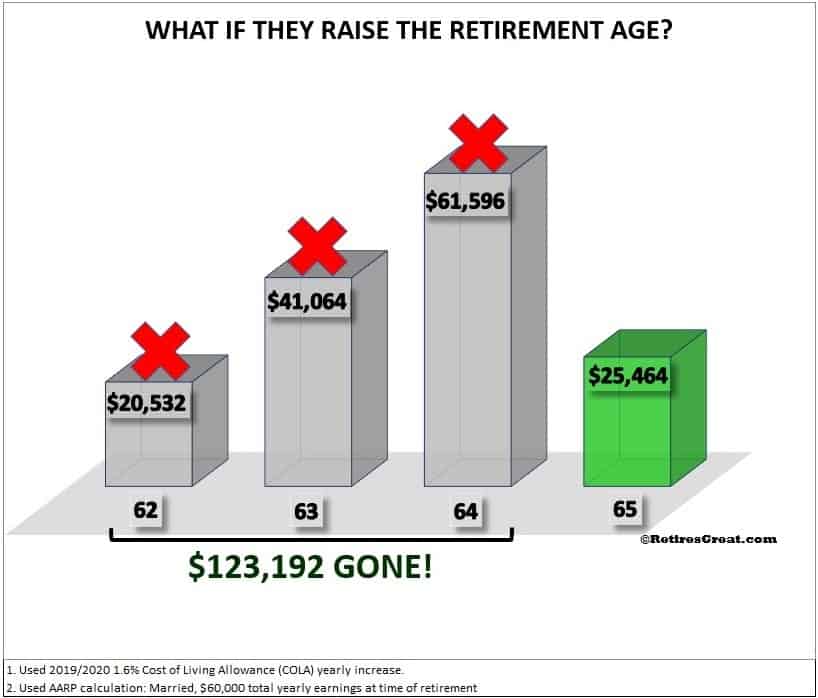The future of social security (SS) and its viability are threatened by the cascading numbers of retiring baby boomers. Recent findings predict that there will be a financial meltdown by 2029!
Already underfunded, the onslaught of COVID-19 has trust funds being gobbled up almost as fast as the space shuttle burns fuel during a launch.
It is going to be around, one way or another, however changes to the program are necessary for it to be sustained.
The Future of Social Security - A Perfect Storm
The impact of a world-wide pandemic further aggravates a program already in a precarious position. According to a preliminary finding from the Bipartisan Policy Center (BPC), trust funds could be exhausted as soon as 2029!
Their projections integrate the recent economic downturn which many consider to be as severe as the 2008 recession. Some of the factors considered include:
Major reforms need to be made to prevent complete exhaustion of the reserves. Trustees wrestle with their options and no one can accurately predict the outcome.
Possible solutions could include reducing benefits, increasing payroll taxation, transferring money from general revenues, raising the age of eligibility, or some combination of these.
Reduced Revenues
This program has always been self-funded through payroll taxes. Things came to a head in the wake of the 2008 recession.
With unemployment hovering around 10%, revenues fell and widespread concern was expressed about the future of social security.
In addition, the labor market has changed. Younger workers have difficulty gaining full-time positions and there remains downward pressure on wages. This reduces the money contributed via payroll taxes.
The program was in rough shape before the pandemic. Trustees acknowledge they would run out of money by 2034. At that point, revenues would only cover about 75% of benefits paid out. Major reforms are being evaluated.
The pandemic and economic shutdown literally came out of the blue! Unemployment peaked at 14.7% in April with an estimated 20.5 million Americans losing their jobs.
Although figures for May show improvement (13.3%), economists fear the economy will be slow to recover.

Aging Baby Boomer Population
There are approximately 75-77 Million baby boomers that make up about 26% of the U.S. population. Ten thousand Americans turn 65 years of age each and every day.
This will continue throughout the rest of decade until 2030.
Never before has society been so top heavy with an aging population! For more information, please read Baby Boomer Facts: The Truth About the Retirement Crisis.
Longer Lifespan
Back in 1935 average life expectancy, more or less, coincided with the age of retirement. Thus, the program was self-sustaining with little risk of running out of money.
Today, people are living longer healthier lives. Average life expectancy has increased to 79, with many surviving into their 90’s. Obviously, benefits are now paid out for many more years than ever envisioned.

Historically Low Interest Rates
Over the past decade, we have observed historically low interest rates. While this was great for anyone borrowing money, it also exerts downward pressure on investment return.
The average SS trust fund return in 2019 was 2.219%.

In March, in an attempt to stimulate the economy, the Federal Reserve cut interest rates to near 0%. This is expected to remain low for the foreseeable future to promote economic recovery.
What does all this mean? This hastens an already dwindling trust fund. With the aging population, more money is paid out in benefits than received.
With record low interest rates, investment returns will be further diminished. A scary thought, inflation might even exceed these returns.
What Are Your Social Security Options?
There are numerous reasons why people enroll at the earliest age possible (62) to take a reduced benefit. These can include:

The old adage a “bird in the hand is worth two in the bush” applies for many Americans. The above reasons and all the uncertainty about the viability of the program has led to 34.3% of people enrolling at age 62.

On the other hand, for every year you delay (up to age 70), your benefits increase by 8%. That’s a better return than most of our investments and almost guaranteed.
Assuming the program remains intact, monthly payments will be received for the remainder of your life. With all the concerns about the future of social security, what should you do?
The following options are, at best possible, scenarios. In truth, no one knows what will really happen. The following graphs are for illustrative purposes of an average couple getting maximum benefits.
Your situation may be different, see SSA to determine your eligibility and specifics. As well, another great calculator is available on the AARP site.
Option A: Everything Remains Good
Let’s assume for the moment that everything will work out fine and SS isn’t in as dire straits as everyone keeps saying. Or, at least, it can be fixed without reducing what you’ll get.
Maybe higher payroll taxes or monies from general revenues will save the day. Regardless, the age-old question for most retirees remains “when should you apply”?
If you want or need money sooner, definitely apply several months before your 62nd birthday. If you choose to postpone, you’ll get more money each month and, ultimately, for the rest of your life.
As an example, if you were to defer until the age of “full retirement” (~67), you would receive the same total income at the age of 79 as those who enrolled at the age of 62.
Moreover, you would receive 40% more (which could be about $740.00 a month) for the rest of your life. The graph below depicts these various break-even points.

As you can see, the longer you wait, the more you will receive. The graph reflects up to the age of 85, yet many of us will survive much longer.
Option B: Benefits Are Reduced in 2029
One of the options bandied about to salvage the program is to cut benefits. Some suggest a 25% reduction would balance the current differential and maintain the program viability.
There’s speculation if even this would be enough!
With so many seniors surviving exclusively on these benefits, I can’t imagine them being slashed across the board. That would cast many seniors into abject poverty.
Still, one needs to consider this as a possibility. Potentially, as early as 2029, trust funds could be exhausted with incoming revenues insufficient to support existing obligations.
That could mean SS income is reduced to 75% of what you were receiving. With this scenario in mind, does it change when you should enroll?
Other than reducing everyone’s income, the decision when to enroll doesn’t change significantly. The break-even point between early applicants (62) and those taking full retirement (~67) extends three years to 82.
The advantage of delaying is nullified somewhat as it will take longer to reach that break-even point.
As the graph indicates, deferring a few years leads to more total income. However, it’s interesting to note, if we knew for sure benefits were to be reduced more of us might enroll early.

Just to mix things up, what if existing recipients were “grandfathered” (no pun intended) and continued to receive the same income? Anyone new would receive the reduced amount.
You’d be right to cry foul. In effect, you are penalized for deferring when to draw it.
Another variation might be to have an “income test” to screen out those more affluent. Again, unfair as each of us have contributed throughout our working lives.
In either of these situations, applying before any such changes are implemented would be a good thing.
Option C: Increase the Age of Eligibility
Another popular thought is to increase the age of eligibility. Instead of 62 being the earliest age, it could increase to 65. Full retirement age might be deemed as 70. In effect, delaying people from receiving benefits for several more years.
Again, it would, again, penalize those who waited unless exceptions were made based on year of birth. Of course, I don’t suspect younger people would be thrilled with an increased age of eligibility.

Another evil twist, what if they made 65 the new 62, but with the same payouts at the new, older age?
Thus, if you and your spouse would have received $20,532 at age 62, this would now be what you received at 65 (instead of $25,464).
Closing Thoughts
There is no doubt the future of social security is in jeopardy. The perfect storm may be an understatement!
Almost a quarter of the American population will be 65 years or older by the end of the decade, coinciding with when the trust fund is predicted to be depleted!
The program will require drastic reform. Existing revenues from payroll taxes are currently insufficient to meet existing obligations. The situation will become more dire as our population ages.
The pandemic has further worsened matters with massive layoffs and high unemployment. Even if the economy quickly rebounds, unrecoverable revenues have already been lost.
Subsequent waves are expected in the fall and winter further retarding economic recovery.
None of the cures appear particularly appealing and it’s anybody’s guess how things will change. For sure, there will some form of benefits program, although it may be vastly different than what we think.


Thank you for addressing this topic. I’m a few weeks away from turning 41 and don’t even bother factoring it into my retirement calculations because I don’t know that it’ll be solvent in the decades to come. I often wish our elected officials chose to work on this issue, even though it’s not sexy and doesn’t appeal to the media, but it pertains to us all and is actually really important. Younger people don’t seem to give it much thought, though they may regret that in the years to come.
You raise a very important point, Katie. Most young people should be more concerned as they are,ultimately, paying for it through payroll taxes.
I, also, agree you should prepare as if it won’t be there. The future is uncertain as solvency is a major concern. Thanks for stopping by!!
Happy upcoming Birthday!!
I can tell you what will happen, I’m a former lobbyist and I feel like I understand why and how congress makes these kinds of decisions. There is no way they will reduce benefits for someone like me. Because my generation votes. In fact I’m pretty confident I’ll get every penny of the $65,670 annual amount they project for me and my wife to draw in a few years. What they will do is grandfather my age group with full benefits and make younger people work a few more years, raise the rates you pay, and increase the maximum income exclusion. This is one time being older is good, we are probably bulletproof, you unfortunately aren’t.
Thanks, Steve, for your insight. Your probably right! We can only hope as we’re not far behind you!;-)